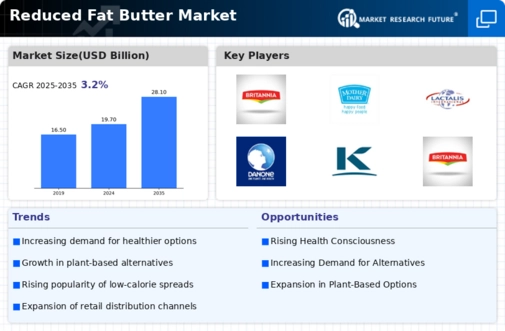Health Consciousness
The increasing awareness of health and wellness among consumers drives the Global Reduced Fat Butter Market Industry. As individuals become more health-conscious, they seek alternatives to traditional butter that offer lower fat content without compromising taste. This trend is particularly evident in regions with rising obesity rates, where consumers are actively looking for healthier options. The market is projected to reach 19.7 USD Billion in 2024, reflecting a growing demand for reduced fat products. This shift in consumer preferences indicates a potential for sustained growth in the industry as manufacturers innovate to meet these health-oriented demands.
Sustainability Trends
Sustainability is becoming a pivotal factor influencing the Global Reduced Fat Butter Market Industry. Consumers are increasingly concerned about the environmental impact of their food choices, leading to a demand for sustainably sourced ingredients. Manufacturers are responding by adopting eco-friendly practices and sourcing ingredients from sustainable farms. This trend not only aligns with consumer values but also enhances brand loyalty. As sustainability becomes a key differentiator in the market, companies that prioritize environmentally friendly practices may gain a competitive edge. The industry's growth potential is evident as consumers increasingly seek products that reflect their commitment to sustainability.
Changing Dietary Patterns
Shifts in dietary patterns, particularly the move towards lower-fat diets, significantly impact the Global Reduced Fat Butter Market Industry. As more consumers adopt diets that emphasize reduced fat intake, the demand for reduced fat butter products rises. This trend is particularly pronounced among younger demographics who are more likely to experiment with healthier food options. The industry's adaptability to these changing dietary preferences suggests a promising future, with projections indicating a market value of 19.7 USD Billion by 2024. As dietary trends continue to evolve, the industry must remain responsive to consumer needs to sustain growth.
Market Growth Projections
Diverse Culinary Applications
Reduced fat butter is increasingly recognized for its versatility in various culinary applications, which propels the Global Reduced Fat Butter Market Industry. Chefs and home cooks alike appreciate its ability to enhance flavor while providing a healthier alternative to traditional butter. This adaptability is particularly appealing in baking, cooking, and as a spread, allowing for a broader consumer base. As the market evolves, manufacturers are likely to introduce new formulations that cater to diverse culinary needs, potentially expanding their market share. The industry's growth trajectory suggests that by 2035, the market could reach 28.1 USD Billion, driven by these diverse applications.
Product Innovation and Reformulation
Innovation plays a crucial role in the Global Reduced Fat Butter Market Industry, as manufacturers continuously reformulate products to enhance flavor and texture while reducing fat content. This focus on product development is essential in attracting consumers who may be skeptical about the taste of reduced fat options. Companies are investing in research and development to create butter alternatives that mimic the richness of traditional butter. This trend not only caters to health-conscious consumers but also appeals to those seeking gourmet experiences. As a result, the market is expected to grow at a CAGR of 3.26% from 2025 to 2035, indicating a robust future for innovative products.





















